Chasing the world record in overclocking CPUs with liquid nitrogen
Hello steemit! Let me share my first story with you!
I guess some of you already heard of overclocking CPUs or GPUs for higher performance in gaming or mining. But how high can chips be overclocked beyond every limit and how is it done? That's what this article is about. My experience with extreme overclocking. But first, let me introduce myself.
I've been a hardware enthusiast since I can remember and always interested in fast hardware. When I was young I could not achieve to buy fast hardware, so I had to get familiar with overclocking. What followed is an amazing story. First, I just overlocked with air coolers. Then I heard of some guys reaching over 5 GHz on a CPU with liquid nitrogen and later even beyond 7 GHz. WoW. 7 GHz. Since I am an absolute nerd concerning hardware, chemistry (and crypto now) I decided to do this. My goal was to get the world fastest CPU (in terms of GHz clock). These days, Pentium 4 CPUs and Celerons (Codename "Cedar Mill") had the fastest clock and nicely they were quite cheap to buy since the state of art was already Core 2 Quad CPUs.
Basically - what do you need to overclock really - i mean REALLY - high?
Three things.
1.) Luck (to find a generally good chip)
2.) Very high core voltages
2.) low temperatures. I mean as low as possible.
(Those times CPUs did not have the "coldbug", a temperature where chips suddenly stop working.)
(1)
So you do not find a cherry CPU every day. Therefore I accumulated some chips and tested them for their overclockability. I chose the best 5 and sold the rest. Luckily I took a picture when I owned all of them (about 40):
(2)
Very high voltage is needed for extreme overclocking. Normally a Pentium 4 has a standard voltage of 1.2 V. For world-record breaking clocks over 2 V are needed. This voltage would burn your CPU nearly instantly with stock coolers. Not many boards are able to set 2V CPU Core Voltage. I was lucky to find one: a ASUS P5E3 Premium which was the best mainboard for my project. No soldering or modding needed. Perfect.
(3) Low temperatures
Some of you may be familiar with water cooling components in you computer. The cooler components are the better they are overclockable. But what else (apart from water) can be done to further push hardware to its absolute limit?
Well, there are more opportunities. Think of chilled water. You could get very good temperatures on your chips (as low as 50°F oder 10°C). Problem? Yes. condensed water. It is definitly not funny to have water drops from your tubes falling on the motherboard. I skipped this one.
What are the other options? Some guys offer phase-changing coolers for computer chips. I bought a single-stage phase-changing cooler (photo below) from an italian guy named Dimastech. It was fully customized and I had lots of fun with it. How low can temperatures actually get? I had temperatures about -55°F / -48°C on my CPU. Hell, that's quite low and has a lot of potential for overclocking. But still way to warm.
After that, there are only 2 (or maybe 3) options remaining. Dry ice and liquid nitrogen (and liquid helium which apparently is way to expensive (about 6€ per litre). Dry ice is basically solid carbon dioxide and has a temperature of -110°F / -78°C. The main advantage is that it sublimates which means it changes from solid phase directly into gas. So there are no problems with any liquid spilling over the hardware - and it is relatively cheap. Really good option for beginners in extreme overclocking. But again... still too warm.
Liquid nitrogen (LN2) is even cooler. Reaching a stunning temperature of -321°F / -196°C. I decided that's the way to go. That time, no one has ever used liquid helium to cool hardware due to its costs (it was later done on sponsored events by AMD). LN2 can be bought at local stores via license. I had a better Idea and asked the staff at university. They have a couple of thousand liters of LN2. I borrowed some dewars (the isolated containers in which LN2 is transported) and asked if I could buy some LN2. The professor asked me why the hell I need it as a private person and I told him about my project. He was amazed ending to donate 180 liters of LN2 to me. What a great person!
LN2 is the way to go. But how exactly is cooling done?
Obvioulsly LN2 can not be poured directly on any chip. The solution is a "cpu pot". Pots are usually made of copper (only private people sold self designed CAD pots this time) and consist of a base and a pipe. The base is heavy and has direct contact to the CPU (just some thermally conductive paste between the base and the chip). On top of that base there is a pipe to fill in the liquid nitrogen which cools down the base of the pot and the CPU itself. With that construction the CPU can nearly be as cold as the liquid nitrogen. Very nice. In order to prevent the pot from being covered with ice due to its extremely low temperature I used a material named "armaflex" which is normally used for heating pipe isolation. That construction should be ready to go. For instance, I added a multimeter to measure the voltage directly and to be independent of software voltage sensors that are not precise when it comes to very high voltages.
Here we go.
What follows is a repeating procedure.
Before Starting: Cool the system to -100°C / -150°F and turn it on
Set a specific voltage (e.g. 1.8 V) and bootup the system
Cool the system down as much as possible with LN2
boost the clock till the screen freezes
increase the voltage
test higher clock
(... increase voltage, test higher clock... while keeping the system as cold as possible)
That way I tested all of my CPUs. It felt so great. Maybe you can imagine this by looking at the pictures of my benchmark-session:
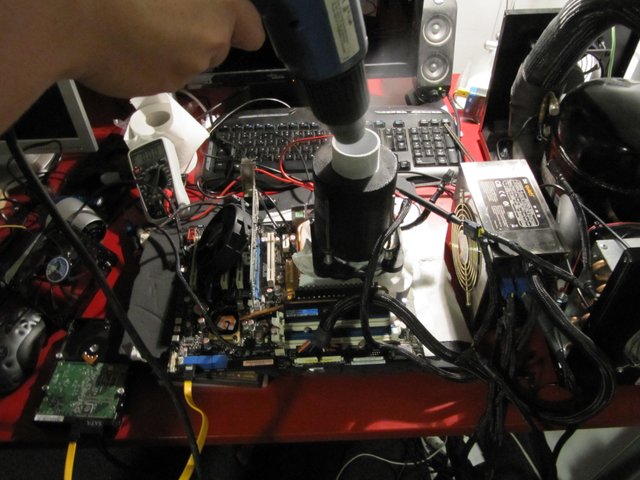
(Heat gun because the CPU would not boot at -196°C - cold boot bug)

(frosty pic of my ASUS P5E3 Premium)
Finally I was able to validate 7.665 GHz:
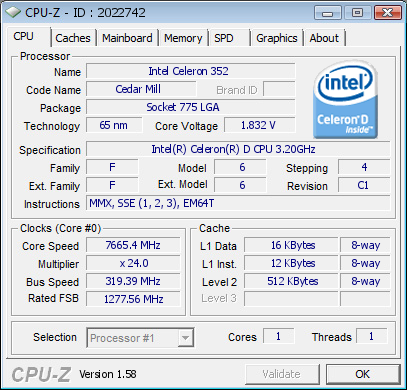
http://valid.canardpc.com/show_oc.php?id=2022742
The actual voltage was around 1.95V, the software sensor just does not work at those limits.
Unfortunately, I missed the world record (which was at 8.09 GHz that time).
That time, this was the best result ever submitted in Germany.
Despite I did not reach my goal, it was a really great experience and worth every penny.
I spend about 2 days without sleep with my hardware and the liquid nitrogen. Luckily
all the used hardware was still working after the torture. Really great stuff. I felt super nerdy though.
I personally thought that people may be interested in that kind of stuff and asked a german hardware magazine if they would consider to write an article about my project. In the end, I got a six page article in their magazine (PC Games Hardware).
I hope you enjoyed the article. Thank you for reading!
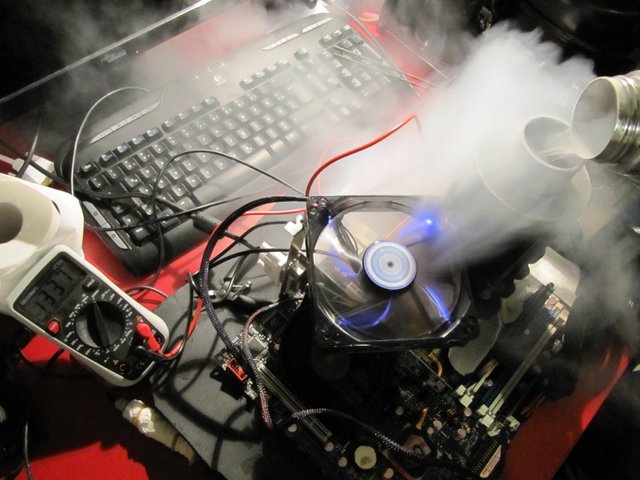
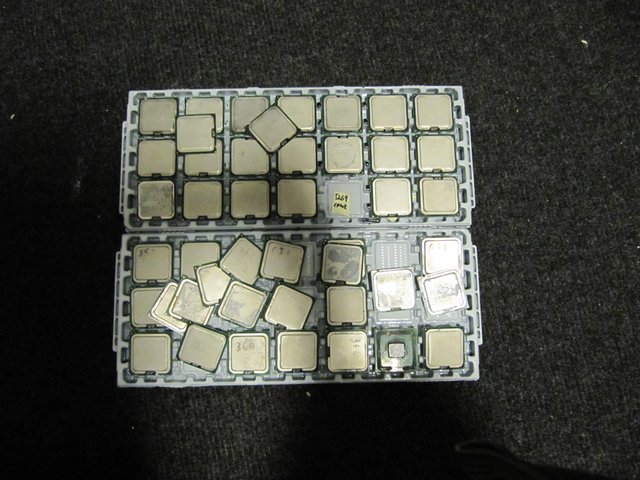
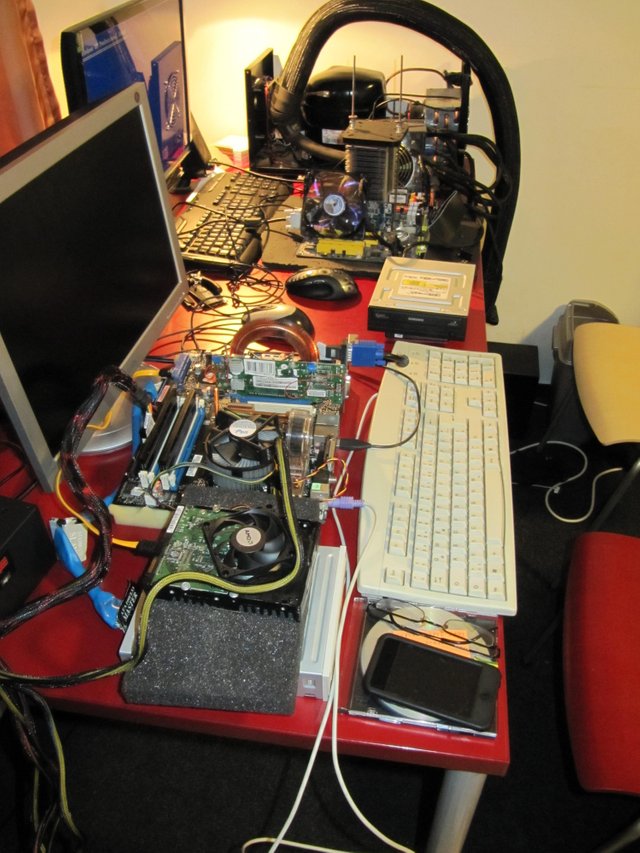
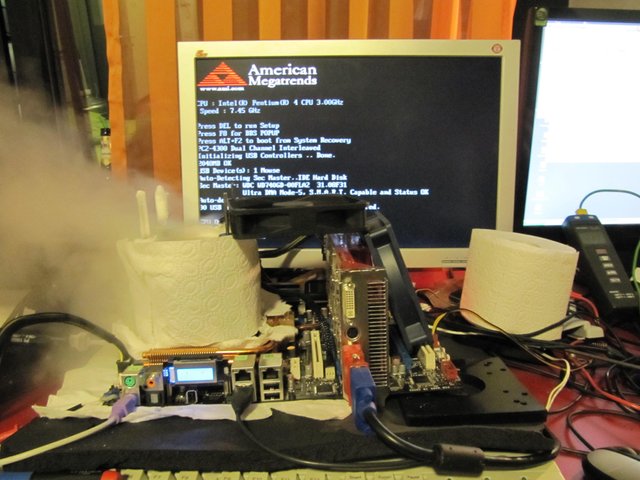
upvoted for LN2. 77 kelvin baby, bring it!
thank you ;)
You might have wanted to mention in the article that seriously extreme cooling (as you depict in the pictures) isn't a great idea under normal atmospheric conditions. While the concept seems sound there's mitigating factors to consider when doing this outside a lab and under real life use conditions.
Serious condensation can form and render your whole build dead in an instant if condensation starts to form and shorts any of the connections. This kind of extreme cooling is typically best done in a near to total vacuum where condensation isn't a seriously mitigating factor anymore.
Great insight none the less but I felt attaching a warning was the responsible thing to do before someone tries this out and learns the hard way that water + electronics don't mix very well... LOL.
I'm only mentioning this because some friends and I lost a rig one night to a similar experiment where we super cooled the liquid of a liquid cooled system after replacing the water with anti-freeze, only to watch the build die when water began to condense inside the system and completely ruined the machine...
On the bright side it was really fun for the hour or so that it lasted but it was a very expensive mistake that we would never again repeat outside of less than ideal environmental conditions.
Yep it is definitly NOT a good idea to mix water and electronics :D.
The good thing about dry ice and LN2 is that they are so cold that there is no condensation / water on the mainboard but just ice. I think condensing is more a problem in cases you described. So with liquids that are a lot colder than the air but still to warm to get covered in ice instantly.
Disclaimer:
That was exactly the problem. We closed up the case instead of using an open air build just like you have in the pictures. Beer and science don't mix very well either sometimes.
Like a bunch of idiots even though we should have known better, we used a closed case and minimal ventilation given the experiment we were about to perform.
It worked great until the lack of air circulation allowed fog to pool into mist, which then became drops of water inside the case. Had we taken the side off the case and kept the humidity down with fans we would have been all good.
Beer however had a much different plan in mind and we very quickly drowned the computer in a miniature rain storm while we drown ourselves in beer, completely oblivious to the total lack of common sense we had used when forming the idea in the first place.
Super cooled semi conductors are awesome and easy to OC when done right, but as you just stated:
And this tidbit of insight can be easily overlooked after a 6 pack or 2...
The sad part is we were very familiar with overclocking but were too drunk to see the flaw in our drunken plans until it was long past the point of no return. In any event it was still fun while it lasted and I literally live in home that looks like a Fry's Electronics collided with a NewEgg truck then spilled the entire payload into my home. In the end we looked at it as a no harm, no foul , but great story kind of an evening. ;-)
The Colder the Steemier ;)